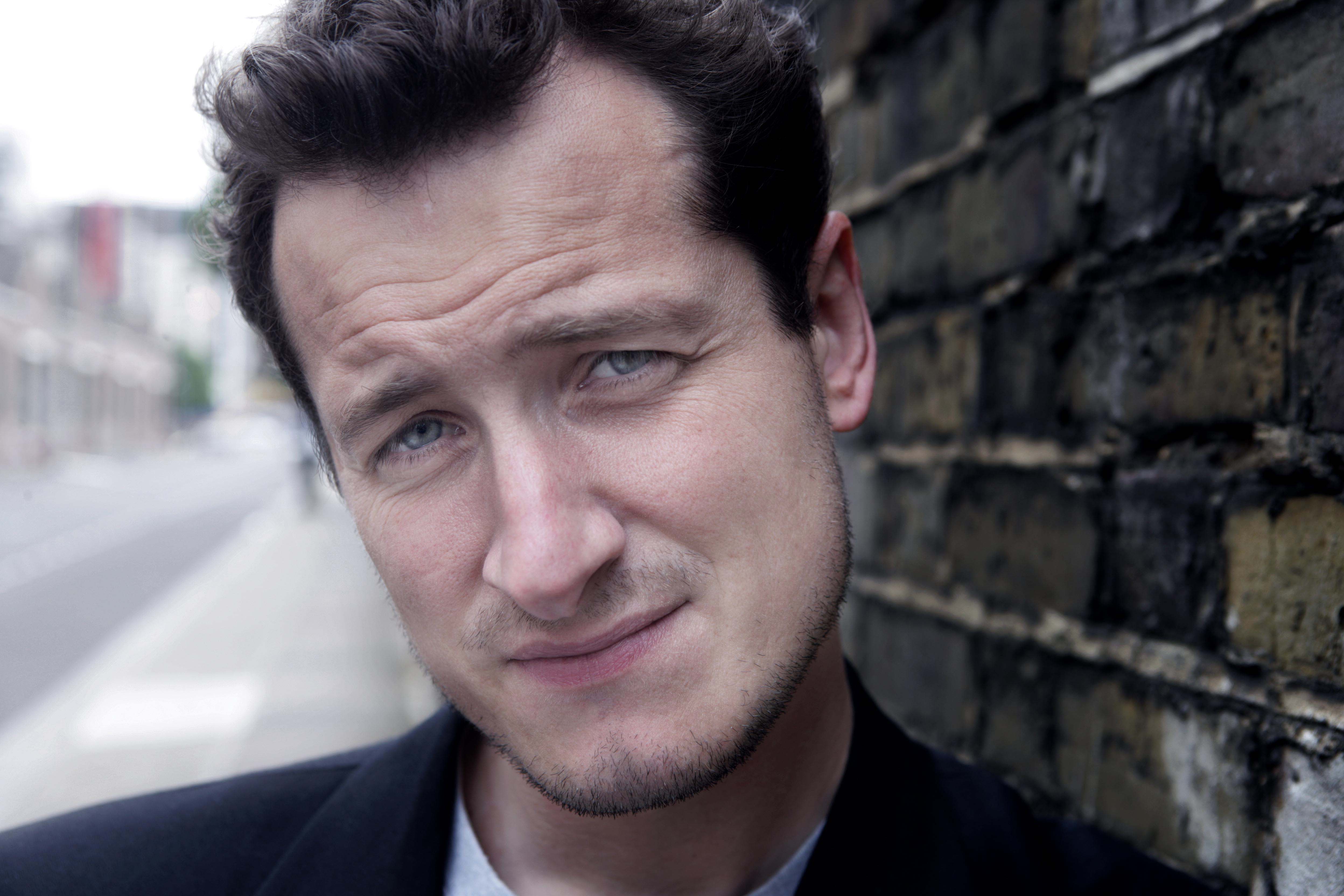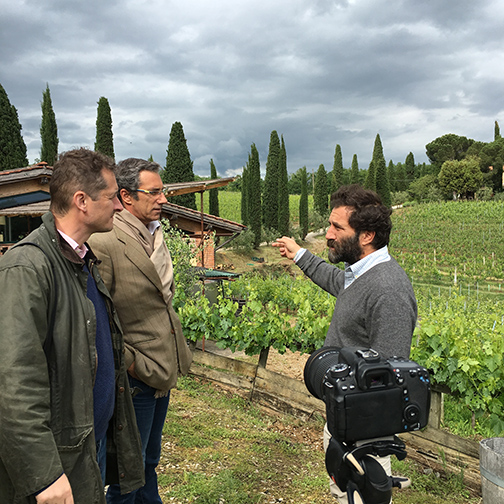
Boscarelli produces consistently elegant and lively Vino Nobile di Montepulciano. The estate was founded in 1962 by founder Egidio Corradi who had a previous career as an international broker in Genoa and Milan. Corradi passed the torch onto his daughter Paola and her husband Ippolito De Ferrari. Today the estate is managed by their sons Luca and Nicolò De Ferrari. Boscarelli is located at 300 meters (980 feet) above sea level on the east side in northeast Montepulciano facing the Chiana Valley.
Monty Waldin discusses organics, branding and the rich wine history of Vino Nobile di Montepulciano with Luca and Nicolò De Ferrari.
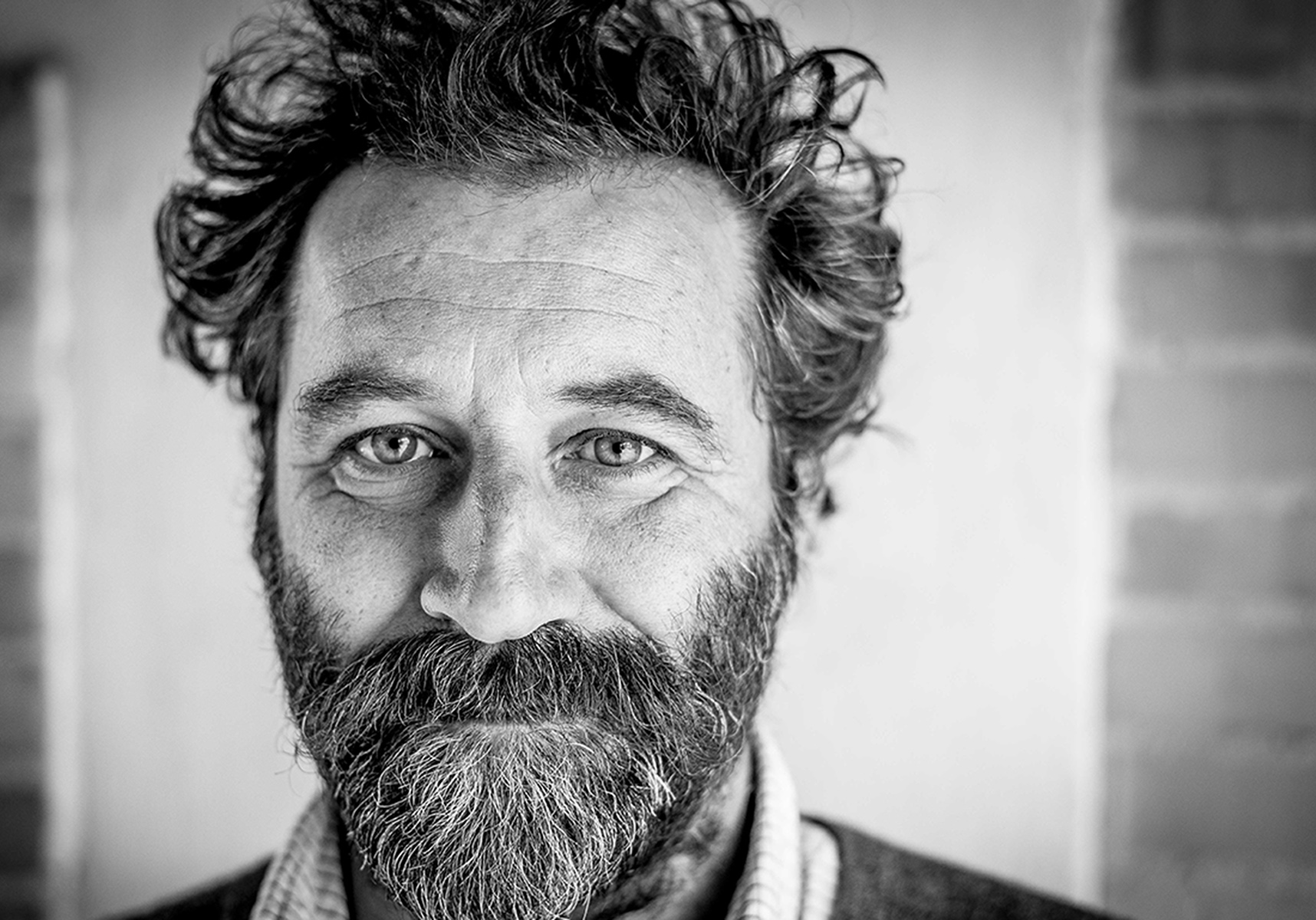
(Nicolò De Ferrari photographed by Monty Waldin)
Monty: Luca and Nicolò, tell us about Vino Nobile di Montepulciano. What kind of wine are we talking about in terms of style and what's it made from in terms of grape variety?
Nicolò: The primary grape variety in Vino Nobile di Montepulciano is Sangiovese blended with traditional grapes like Canaiolo and Colorino, and so on. The idea of Vino Nobile depends on the soil. Sangiovese is like a lens that gives the wine what you have in the soil (the soil influences the wine) All the area of Montepulciano is alluvial. We have several different layers of sediments that could change.We have mainly red soil, which is sandy. In other places, in the lower part, also in the upper side, we have more clay, more limestone, or more stony soil.
What effect does it have on the grapes ripening? Do you pick everything together or separately?
No. Everything changes because of the soil and the changes in temperature. A few meters could change the temperature a few degrees more or less. That has a big influence on the ripeness. This is the reason that we work on single parcels. Each single parcel is harvested at the right time. Each produces its ideal about the right point of ripeness, but we don't like to over-ripen the grape. We don't like to over-extract the grape. Our harvest in a regular season could last from 20 to 25 days.
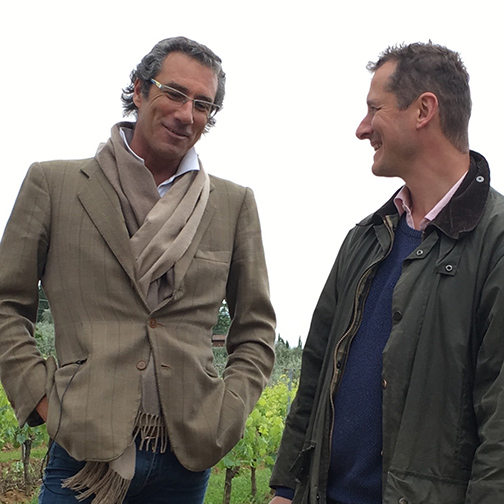
(Luca De Ferrari (left) with Monty Waldin)
People always get very confused between Montalcino, which is a very short drive away to the west, and Montepulciano, the town of Montepulciano, and you call your wine Vino Nobile. First of all, why do you call it Vino Nobile, the noble wine of Montepulciano?
The name Vino Nobile is centuries old. Montepulciano is really an historical area for the production by the Etruscans and through the Romans and so on. In the past, the quality of the wine that was produced in Montepulciano was indicated as the nobility of the wine coming from the area of Montepulciano. Nowadays, Montalcino is perhaps well known, better known than the Vino Nobile, but the two areas are near, only 50 kilometers from each other, but they are different because the soils are different and everything is completely different.
Here, we have sediments. They are on a volcano. They have rocks. They have clay. They have many more forests and they are on the coast. They are on the first mountain off the sea, so the quality of the air is different. They have cleaner air than here in Montepulciano because we are in the middle of two mountains. We have the Appenines on the north, and Montalcino and the Monte Amiata, the systems on the south.
Are you saying that the growing season here is a little bit short? When you mention cleaner, what do you mean?
Cleaner means that the sun radiation is harder in Montalcino than here. It's harder because here, we have always a little bit of filtering by the air. The temperature in Montepulciano is a little bit higher. They have storms coming directly from the sea, and here everything is sweeter.
You mean more protected from the sun?
Yes, we are protected. We are in the middle. The sun radiates less, but the temperature is a little bit higher. This has a big influence on the ripeness of the grape.
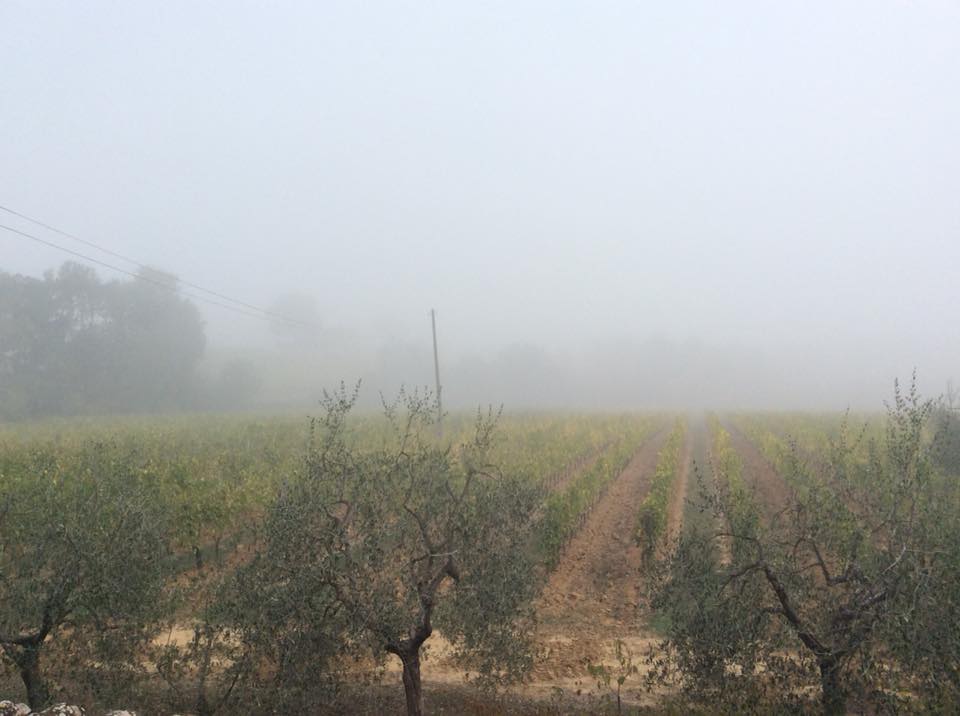 One of the differences between Brunello di Montalcino is that it's only made from Sangiovese here. You can make just 100% Sangiovese while we can also blend in other Tuscan grapes, as you said earlier, for example, Bordeaux grapes or Cabernet, Merlot, and Syrah from the Rhône.
One of the differences between Brunello di Montalcino is that it's only made from Sangiovese here. You can make just 100% Sangiovese while we can also blend in other Tuscan grapes, as you said earlier, for example, Bordeaux grapes or Cabernet, Merlot, and Syrah from the Rhône.
Yes. The reason is because Montepulciano is where all these grapes were when the Romans were producing. For centuries, there were no rules for the production. Each small area, because of all the changes in soil and temperature, is good for a particular kind of grape. Historically, we added hundreds and hundreds of kinds of different grapes. Then in the '50s, the Sangiovese grape was the most dominant. It was all focused on Sangiovese, but all the rest remained. Because of this, traditionally, Vino Nobile is a blend, because consider that on the massale selection, that is the way used for centuries to replant the vineyard.
It means that you take a branch of vine and you replant it. You move all the different varieties you have in the vineyard. Now after 30 years we use the clonal selection so we know that all the plants have exactly the same DNA, and we know that all the Sangiovese and all the Colorino are what we want. Before, everything was mixed because this was a blend.
You're saying in the old days, people would have mainly Sangiovese and everything else, but other grapes as well.
Yes.
They weren't necessarily exactly the percentage because they will just plant it whenever …
It was a blend and then we made a research study, so you get mainly Sangiovese and there are all the rest of the varieties. This is the reason because until the '90s, the late ‘90s, we were not allowed to produce 100% Sangiovese because the reality in the vineyard was that they are not 100% Sangiovese.
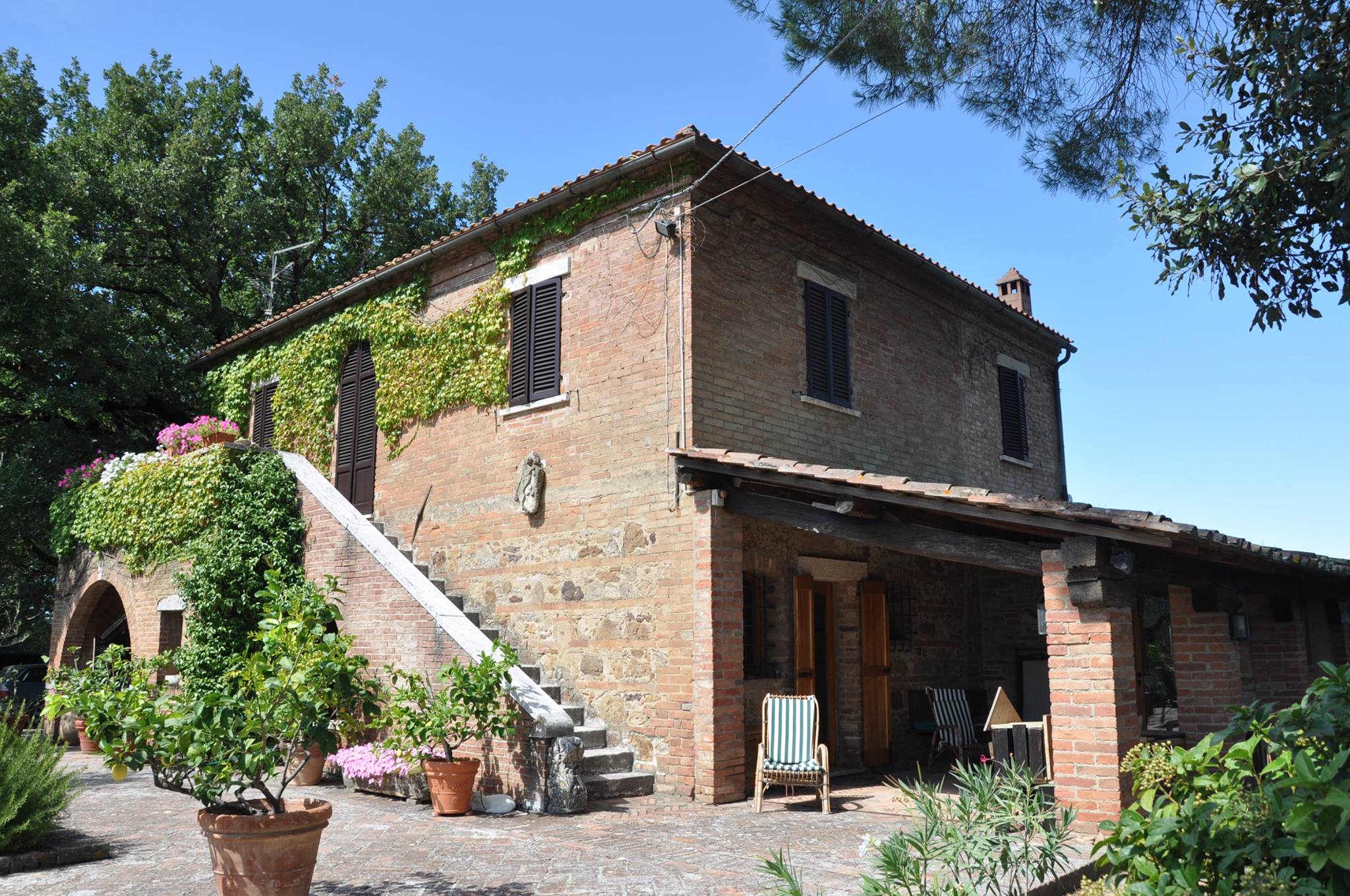 Basically, the law was respectful of the tradition here, which was that the vineyards were mixed. It wasn't just a one grape variety, as you said, Sangiovese, law. You’ve got these mixed vines, therefore we respect that, which means it's legal to have a blend.
Basically, the law was respectful of the tradition here, which was that the vineyards were mixed. It wasn't just a one grape variety, as you said, Sangiovese, law. You’ve got these mixed vines, therefore we respect that, which means it's legal to have a blend.
Yes, because it was real. Now, it's possible to produce 100% Sangiovese and it is the focus of many producers to have a great 100% Sangiovese. Now we can.
Do you think the French influence here is declining, in terms of the grape variety selection in the vineyard and in the winery, or the use of French oak barrels, for example?
Yes. The world of wine is full of fashion. The late ‘80s and the '90s was a fashionable period for oaky wines. Everyone was looking for more structure and more color, because the market wanted those qualities. We tried to maintain our tradition. For sure in the cellar, we have, as you see, many barrels.
The difference within your oak barrels is you only had a few French oak barrels and you kept them for years and years and years. By the end, they didn't give any oaky taste of wine. You weren't buying hundreds of new barrels every year, were you?
Yes. We experimented and worked with several different tonneliers, with different sizes, and different kinds of oak. Now, we have exactly what we need, and our choices during the '90s are still in use— they are 12 to 15 years old, with no taste of oak. There is a good osmosis process through thin oak. It’s good for us because we work within a single, small way, because harvest means harvesting in different places, a few per day. It means a small way, that age separated each. We need the big one as well as the small one to keep each grape separated.
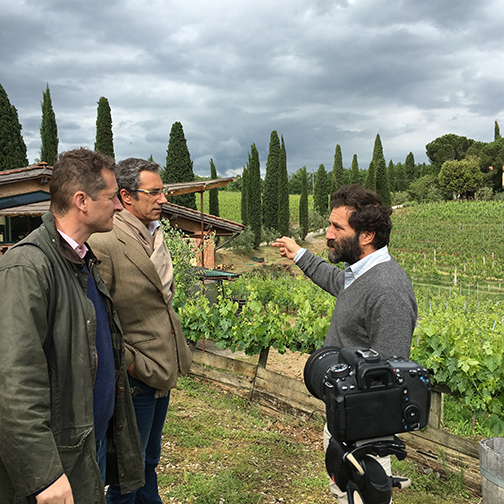 How do the producers in Montepulciano, who make Vino Nobile, feel compared to its really famous near-neighbor Montalcino? They get all the press and lots of high scores from journalists. Do people here feel a little bit undervalued?
How do the producers in Montepulciano, who make Vino Nobile, feel compared to its really famous near-neighbor Montalcino? They get all the press and lots of high scores from journalists. Do people here feel a little bit undervalued?
We do feel undervalued for sure. We think it's not the quality. Absolute quality doesn't exist! Each area has its own taste and so transmits its taste. For sure, Montalcino has a marketing strategy that is focused. They started together and together had the same idea and worked in the same way. They are forced to penetrate the market that is 100% Sangiovese. It's easy to remember. Montalcino, Brunello is easy to remember.
We have Vino Nobile di Montepulciano. It's a blend, its a bigger area. A bigger area, but different selection, different soil, different blend. It's more complex too. To communicate this complexity, it's much more difficult.
Apparently one of the reasons that Montalcino became famous and you didn’t, was that there were a number of big American producers that established themselves and were very good at communicating with a ready market in the USA. Whereas, you didn't really have that support system. You're very much small local farmers, farming Nobile, compared to some of the bigger producers when the Brunello boom started, and that came from abroad.
If you consider the average size of the estate in Montalcino, they are much smaller than here. We have 14 hectares and are quite small producers. The smaller estate here could be five hectares, six hectares. In Montalcino, you can have an estate of two hectares, one hectare that produces a few thousand bottles and could stay in the market. In Montepulciano, we do not have a small estate that produces 2,000 bottles and can be in the market.
And manages to survive, financially, you mean? With a small vineyard, it's hard to make an operating profit with so few bottles to sell?
Yes. The price level is too low to produce 2,000 bottles and to have enough to invest and to do. The smaller ones sell the grapes, prefer to sell their grapes directly and not produce wine with their own label.
If I am a professional wine buyer and I want to purchase a normal Vino Nobile and a normal Brunello, is Brunello 50% more expensive, 20% more expensive on average, 100% more expensive, roughly? What is a base price?
One-half. The Vino Nobile is half than a Brunello.
They get double the price?
Double the price. The Brunello fetches double the price roughly. We are never with the same vintage in the market because they are one year more on aging. If you consider, roughly, it's, yes, it's 40, 50. We try to increase our prices to reduce this gap, but I am talking about average prices.
 That's incredible! Your farming costs are the same. A person pruning a vine in Montalcino and a person pruning a vine in Vino Nobile is going to get paid exactly the same money, but you're saying that your selling price is only 50% of theirs. How did you survive financially? How are you going to survive and communicate why your region is special so that people do give you more money for your wine and all of your hard work?
That's incredible! Your farming costs are the same. A person pruning a vine in Montalcino and a person pruning a vine in Vino Nobile is going to get paid exactly the same money, but you're saying that your selling price is only 50% of theirs. How did you survive financially? How are you going to survive and communicate why your region is special so that people do give you more money for your wine and all of your hard work?
We're producing wine for ourselves. It's not a business. It's a passion. We produce because it's a passion. It's not great. We do it because our grandfather started it, and we trust in the quality of our vineyard. We work this way because we trust in all of this and we want to be proud to have the best wine that this land can produce, as our grandfather wanted to.
Your grandfather started producing wine just for the family table didn’t he? How did you take that step from just drinking it as a family to then selling, and turning it into a business? How did that happen?
Our grandfather was from here and he liked Vino Nobile a lot. When he decided to buy these two small estates, he decided to produce a few thousand bottles of Vino Nobile in the best way for himself for his friends. He didn’t want to be engaged in the wine business. His idea was to plant 10 hectares of vineyard, sell the bulk of it, take the best selection for himself and produce 2,000 bottles per year.
Which year was this?
It was 1962. He started to plant the vineyard in 1962 and '63. In between '62 and '71, the estate was all planted, but our grandfather died in 1967. It was our father and our mother who decided to invest, finish planting the vineyard, make the first label, and not sell the grapes, but ferment all the grapes they had.
When he died, you must have had a little bit of wine in the cellar. Did you think, "This is great. We can just drink this ourselves," or did you think, "Maybe now is the time?" How did you start selling it?
I was not born in 1968. I was two years old in '71 and '72 when they started. As I remember, our father was going not door-to-door, but in the restaurants showing up and saying, "We are a new producer. We have this production. Who would like to taste this for us and give your opinion?" and so on at the beginning. In this sense, we have also been lucky because our family is from Genoa. Our grandfather was from here, but he was living in northern Italy. Our mother and our father are from Genoa.
They married in Liguria. My brother and I grew up in Genoa and completed our studies there. On the way up and down from here to Genoa, there are several good restaurants. In those days, the way was longer. There was no highway. They stopped in different restaurants. One place was where Veronelli, one of the most important journalists in Italy, had the opportunity to taste our wine, because our father gave a few bottles for tasting and the owner was in touch with Veronelli and they tasted the wine together.
We found our wine, our label, without any information, on the best 100 wine list in Italy in 1976. This was the moment we decided, that we had to remain in this group of the best wines. This is the reason we didn't grow. We continued to study to achieve the best results from our vineyard, replanting the vineyard, reselecting the old vines, the old selection, and trying always to remain on the right point, not locked in the past, but not running to the future. Always looking at what could be, what we could do, but we are here and we start with the land.
 Can you tell us about your terroir?
Can you tell us about your terroir?
The area remained under water two million years ago, and then had been pushed out altogether. The layers of sediment, and there are several different sediments, are field perfectly straight. During the period of the continental alluvial, some area had been eroded and dug out by the water flow, and some area had been added soil. This depends on the area and the position, the side of the hill and the height.
Here for example, the soil is mostly red sandy soil. The Vina del Noche, 40 meters higher than here, is full of limestone without any iron composition. Everything is more on white and is on the top of the hill. It's windier. Here we have a wind that is the thermal movement from the lake and the higher side of Montepulciano. There is always a good ventilation.
Altogether, here in Boscarelli it's always a little bit windy, although not as strong a wind as today. This is a storm, but it's always a little bit windy which is good for the health of the plant, good for the soil because of the sandy composition. It's a great potential for drainage. Here, also after 25 millimeters of rain in one day, we can go in the middle of the field without any problem. If you go in the parcel we have back down there. There we have lots of clay and with clay, we have to wait two days.
You're saying the soil is very varied here.
The soil changes, continuously changes. This is the reason we can talk about the climate we have on this side of Cervognano and this side of Montepulciano, but also with the same climate, we can have different opportunities or problems, or opportunities because of the soil that changes.
It's a little bit like Burgundy where if you move a couple of meters, you might be on a white soil or a red soil, or a heavy soil.
Here, it's the same way. On average it's more red than the upper side, than the other side of Cervignano.
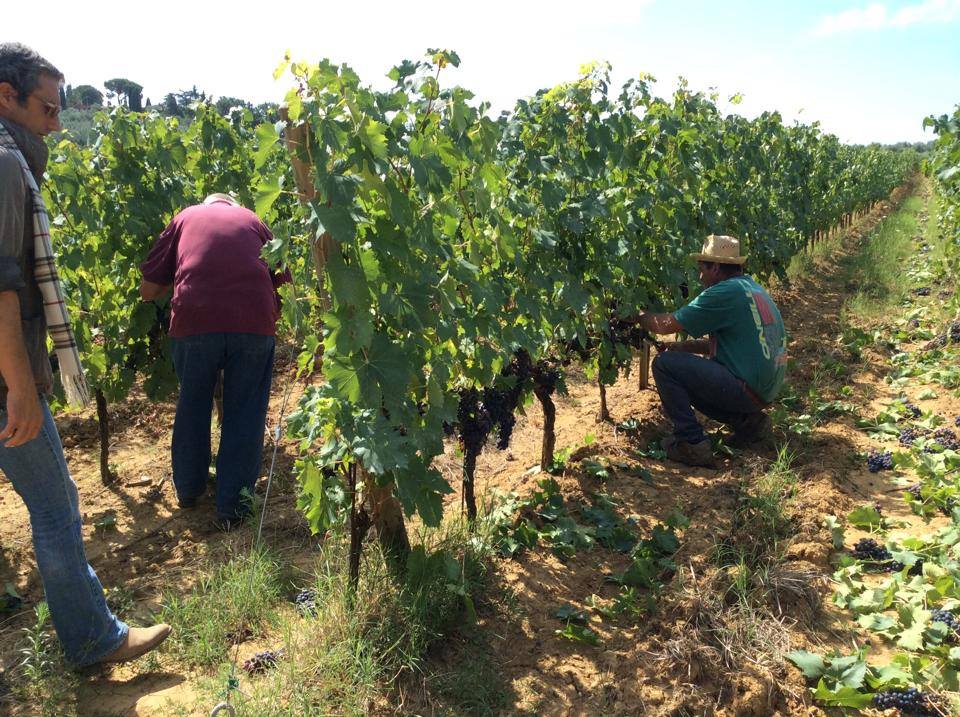 You're growing a Sangiovese on this iron-rich red soil and you're growing a Sangiovese on the white soil, what is the difference in taste?
You're growing a Sangiovese on this iron-rich red soil and you're growing a Sangiovese on the white soil, what is the difference in taste?
From the red soil, we have much more character, not for structure, but character. The tannins are a little bit tight. From the white soil, we have also the texture of tannin which is much more ...
Silky?
It's silky but I don't know. My brother and I talk about the density of the tannin, which is like powder and sand, a similar quality, but one is more dense, more soft. That is one. From the notion here, the differences are also in the temperatures and so on, the higher part. Half of the Nocio (vineyard) is south-faced here. We are also always northwest and northeast facing, so there are several different changes. On the clay, for sure, we have and we have down there. We have small lands here. We have more structure, more body, its a little bit richer.
Here, for example, the climate in the lower part, on our back, is 15 meters lower. The soil changes a little bit. It's a little bit less sandy. There we have grown Sangiovese for 30 years and we never achieved the quality we wanted, always all unripe but we have to harvest because the problem of the season. Too much acidity, not the right structure. This is one of the reasons we have have changed some varieties, the Colorino, for example, in the same place which grows in a perfect way.
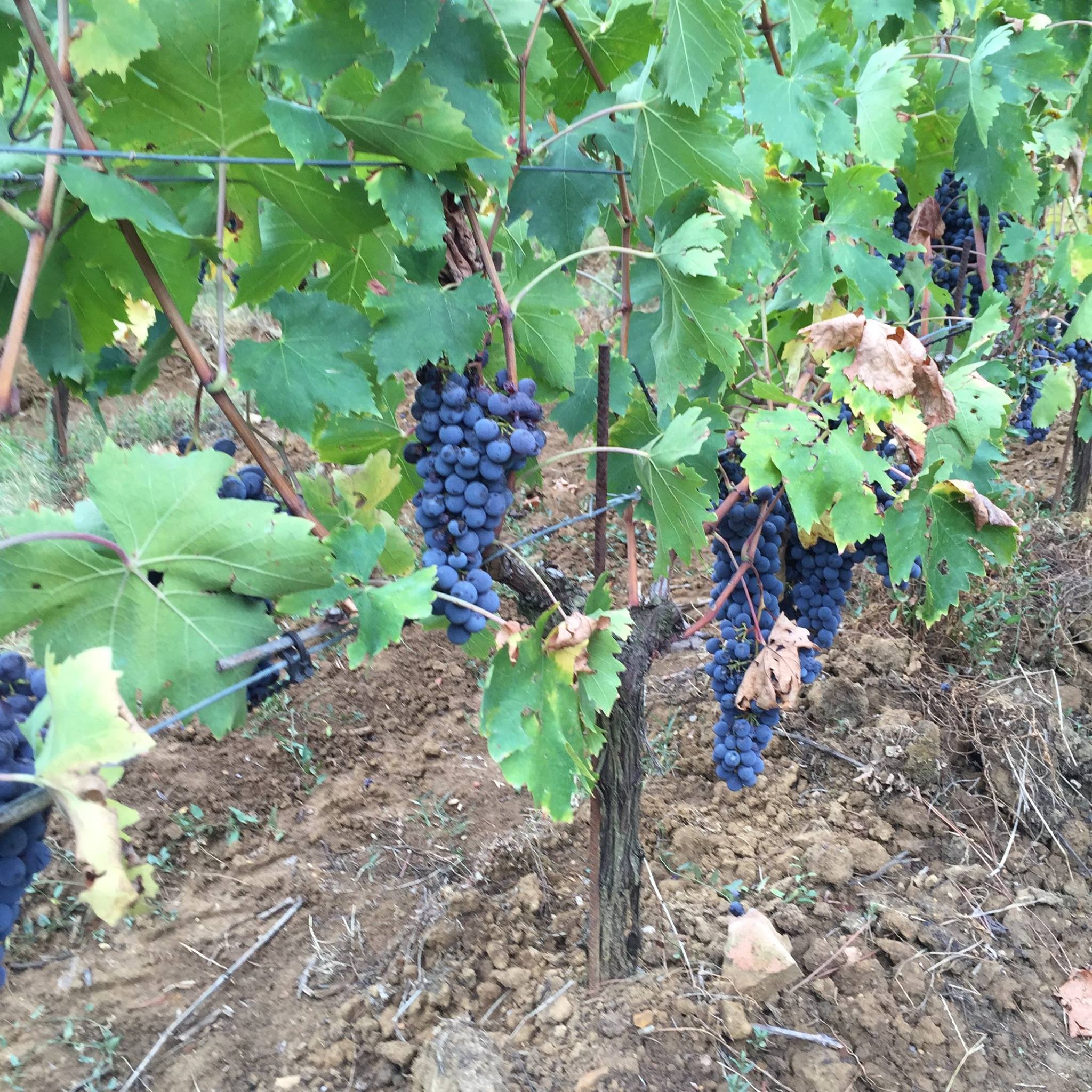
Luca, You’re in charge of selling the wine, how easy or difficult is it to describe Vino Nobile, because people tend to confuse it with the Montepulciano grape from Abruzzo and then perhaps there may be confusion with Montalcino. How easy is it?
Luca Ferrari: Selling Vino Nobile is not an easy task. It reminds me of our idea from the beginning, from my grandfather, because the Vino Nobile is an historical wine, that is historically famous. It is a really important name. In the market in the last years, it has not had the success that it should have, because there it's famous in the history for the producing wine.
In the 1960s, my grandfather started with an idea, because the Vino Nobile at the beginning of the 1900s was really famous. It received a gold medal in Paris. He was a wine lover. He was from Montepulciano. He lived all over the world. He lived in Milan. He was a broker. His passion for the Vino Nobile led him to buy the best place in his opinion in Montepulciano to produce Sangiovese, the Prugnolo Gentile and make a good Vino Nobile, and from that point to restart to introduce the name all around the world.
Honestly, we didn't manage to do this because he did in 1967. My mother, particularly my father brought forward the task. We started with the first 2,000 bottles in 1968 of the Vino Nobile and for the reason that they have to live between Genoa and Montepulciano because the origin of the De Ferrari family is from Genoa. We drove all week to make the wine here in Tuscany. During this period we spent time in good restaurants in the area, and had the chance to leave the wine at Paracucchi in Florence.
Paracucchi met (the wine critic) Veronelli and tasted this wine and was surprised by its quality. This helped us in the market because we were included in the top 100 wines in Italy. In a short time, they were surprised. My mother and my father, they had really good success. We know this when we speak about the difficulties in the market for the Vino Nobile.
The problem in the last 40 years is that the Vino Nobile has been confused with the Montepulciano d’Abruzzo and that obscures the identity of the wine, because they are two completely different wines.
What is the difference between Montepulciano d'Abruzzo and Vino Nobile di Montepulciano?
There is a huge difference between these two wines because one, the Vino Nobile di Montepulciano, is a wine from Tuscany and has the name of the village and the area where the grapes are grown. It's the Sangiovese grape that locals call Prugnolo Gentile. Montepulciano d'Abruzzo is a Montepulciano because it's a grape called Montepulciano and it's made in Abruzzo, so they are two different wines..
Your wine comes from the town of Montepulciano City, an ancient city in Tuscany. Montepulciano d'Abruzzo is the grape from Montepulciano, grown in the Abruzzo region, which is in a completely different part of Italy.
Both are great wines, but completely different. It’s confusing because of the name, that’s what compounds this confusion. The task is to explain to the market that they are different.
There's also confusion between Brunello di Montalcino and Vino Nobile di Montepulciano. Historically, when was Vino Nobile di Montepulciano first produced and when did Brunello become famous?
There are a lot of little connections in that case of explaining this reason because as I mentioned, the Vino Nobile has a long history. You have many artists that spoke about it in the 1880s.
How far back then? What about the popes, the medieval period?
The popes. There is a lot actually in the past, in the medieval times. The famous Italian classical scholar and poet of Florentine Renaissance, Poliziano, has spoken about Vino Nobile.
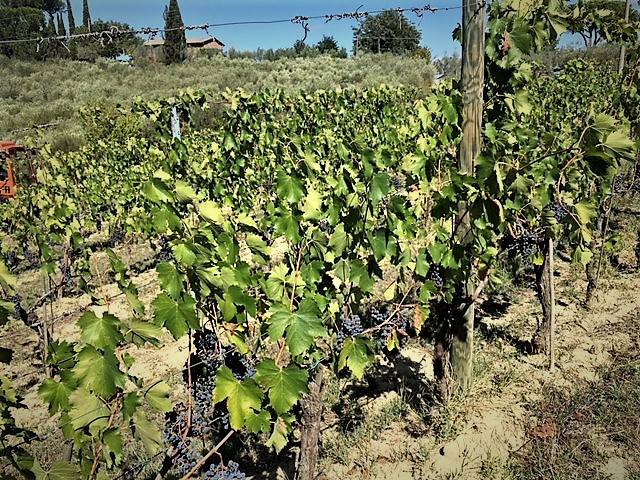 This was approximately 400, 500, 600 years ago.
This was approximately 400, 500, 600 years ago.
Yes. The difference is that Montalcino had in the past Biondi Santi, who had a great idea.
How long ago was that then?
Maybe 130 years ago. Vino Nobile has a long history, but we know that in the '90s it was less powerful, this quality, this image. In the meantime, Montalcino was lucky that they had a big important investor, an American that has built a really big, huge production of Brunello di Montalcino (the Banfi winery, owned by the Mariani family) and made it famous all around the world. Montepulciano is a different reality. It's more shared in different ideas of production.
There are big important producers that have invested a lot in this area. Now is the time to find the goal, to represent the Vino Nobile with history and with a wine that has a good rapport in price and in quality. We have invested a lot in this area, in the vineyards in the last 20, 25 years.
You're saying that Vino Nobile di Montepulciano is a better value than Brunello di Montalcino?
Absolutely, yes. I'm sure. Anyway, they remain two different wines, both are made with Sangiovese, but the Sangiovese that is so sensitive to the soil and the climate where it grows makes different wine. In Montalcino, the climate has the influence of the sea. The Sangiovese Grosso, they use with the soil and they made a wine different from Montepulciano.
In what way?
My idea is to create a wine that is important, complex, but also a pleasure to drink and more easy, and connecting with food, with good acidity and elegance. In this idea, the global warming that exists helps in our production because if it should have a limit for Montepulciano, it's the temperature, the average temperature for the climate.
What is your strategy to make the wines of Montepulciano, the Vino Nobile, better known in the market?
The strategy of Montepulciano firstly is to point out that we produce quality, quality that come from the vineyards that we have built in the last 20 or 30 years, replanting most of the vineyards. The second point is to make a similar idea of the Vino Nobile, so work mainly with the Sangiovese of the area, with the fresh fruit, full of elegance and not just powerful. That is the second step to have an identity on the market.
We need to communicate what we are doing and what we have done in the last 20 or 30 years. That is a lot. Using our name and limiting the confusion with Montepulciano d'Abruzzo. With the price point we have, we can manage to improve the market and people’s perceptions about the Vino Nobile.
Has your modern Vino Nobile style changed? Wines that are are a little less big, a little less heavy, something that's a little bit more fluid, a little bit easy drinking, but still complex?
I think this, yes. I think that’s my idea and the goal of the Vino Nobile in particular. But also to have its own personality. We too in Boscarelli have been producing wine for 50 years. In looking at this idea, we look to the wine producers in the '70s and at the beginning of the '80s, then the '80s and the '90s where we were looking for a wine that was not our wine. It was the opposite. The idea of producing wine was the opposite (a big and fruity style of Sangiovese).
What were people doing differently?
In the '90s, we were making a wine because we had an idea of the type of wine that we wanted to produce. Now, it's changed from 2000 and we produce the best possible in this area, not deciding before which one we want to produce or what this area, with this grape in this area can produce.
In the '90s, why was there a fashion for big oaky Bordeaux-style wines?
Why? I don't know exactly why, but there are different reasons. The market and the influence of journalists and reviews, of course. Wine in general is a fashion and so it follows the ways of the period. In that moment, they were looking at the journalists and the market for huge wines, fat, rich in oaky flavor. All the producers had taken the idea of the Bordeaux wine and the Super Tuscan. Everybody followed that trend.
In spite of this, Boscarelli has a tradition for a wine made with Sangiovese, always with acidity and elegance. We were influenced by this kind of wine, but we didn't manage to exaggerate this style. Absolutely, we preserved our style.
Were you able to do that because your wine became famous as a result of the encounter with Veronelli, and became a wine success in restaurants? People wanted to drink the whole bottle, not just have a glass and fall over?
Yes. Despite the trend, we managed to produce quality. Our mission, our idea of producing wine is to make a wine that is a pleasure to drink, and you want to drink it, and you like to drink it, glass by glass, and the bottle.
Does that mean the Boscarelli style is more elegant, more refined, if you like? Less oaky styles are now coming back into fashion as tastes change?
Yes. Absolutely. As I told you, speaking about the vineyards, absolutely. You know that we have replant most of the vineyards in the last 20 years and in the last area, we have used selected clones from different areas and different universities of Italy. We feel that if we want to express exactly the fruit and the freshness of this area, it is better to use the clones that were planted in the '70s and in the '60s.
In the new vineyards that we are replanting, we are taking a massale selection of the old clones of my grandfather.
You always pick your grapes ripe, but not overripe. There was a fashion as well in the '90s to make these very jammy wines.
Yes, but honestly, I can't say it was an idea of my grandfather, or because this area has produced this kind of wine. If you look and analyze the character of the Boscarelli wine, it come from the soil and our climate. This is an area that, for the fact that it is a little bit warmer than the other, the plants started to grow early compared to the rest of the areas.
The factor of the soil, this red soil with clay of alluvial origin, with stones and shells allows the roots to go really deep. This allows the plants constant growth during the season, in spite of the weather conditions - warm or humid- and keeps the acidity, thereby allowing us to have a really long period of growth for the grape. We can wait later to harvest and still with a good acidity and ripe fruit. This is the character of the Boscarelli wine, absolutely. We have our mind and our body, but it come from this space.
That was thanks to your grandfather. He identified this as a very special area to plant grapes all those years ago. An area where you could let the grapes ripen and they would ripen healthily so you get ripeness and freshness.
Because more constant and long is the life of the vineyards you have in the vintage and the wine you produce in the vineyard.
Your family name is Ferrari.
De Ferrari. We lack for the De and we do not have a Ferrari. We make red wine, a Ferrari wine and not a Ferrari car.
Although your family name is Ferrari, a very famous name in Italy, your estate is called Boscarelli. What does Boscarelli mean and why is it called Boscarelli?
Boscarelli comes from this area of Cervognano. Boscarelli means little forest, because this was an area of forest.
In Italian, bosco means forest. ..little wood or forest.
Yes. Little wood, forest. These are the names of the two farmers that lived in this area. De Ferrari and Corradi, especially, that is my grandfather's family name. The De Ferrari family is from Genoa. We have used the name of this estate and not of the family, in a way, it is a special connection with Ferrari.
In the old days, there were no streets, street numbers or names here. It was just an area with a little bit of forest that locals would call it the little forest. They would call it Boscarelli and you kept the name.
Yes. This was a really famous forest, specializing in mushrooms, in porcini and also in truffles. This is a special area also in this situation.
Do you still find truffles here?
Yes.
What color are they?
Some are really small. In some part of the season you can also find white ones, not the black, rough ones. We didn't know about this. We are just discovering it recently as the old people tell their stories about when they are at the end of their life, and they confide in people.
Which would be more profitable, truffle farming or wine growing?
No. I don't know about truffles. I like truffles especially, but no, our passion is to make a real good Vino Nobile and make a more powerful impact in the marketplace, because it's a wine that we are proud of and it is a special wine.
Undervalued! What should people eat with the Vino Nobile?
Honestly, I like the Vino Nobile particularly with a first course, a pasta or a risotto. I think it would be a good match as part of the classic cheese and bistecca Florentine and so on. In my opinion, rich first course, risotto and pasta, it should be really good, perfect.
Monty Waldin was the first wine writer to specialize in green issues. JancisRobinson.com said of Monty’s latest book, Biodynamic Wine (2016, Infinite Ideas Oxford) that “it made me realise I knew next to nothing about biodynamics.” Buy it on Amazon.
More from Monty Waldin on Grape Collective.
(banner art by Piers Parlett)
